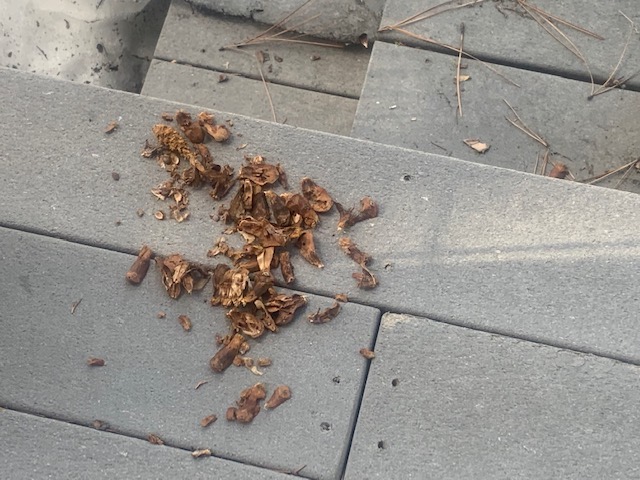
Pinecones shredded by a hungry squirrel.
By Jacqui Banaszynski
Consider the tease of the writer’s muse. We wait and wait and wait for her to show up, and get more anxious about her absence as deadline nears. So we thrash through something as the clock ticks ever forward until, if we work in a world of true deadlines, we have no choice but to hit SEND. Then we fret. We shrug. We try to shake it off. We know we didn’t do our best — or even very good — work. Then later, in the middle of a restless night or a compulsive bit of cleaning, there she is, grinning and tsk-tsking.The Muse has appeared — but on her terms and timing, not ours.
I learned some time ago that the Muse best helps those who help themselves. (Echoes, yes, of my 1950s semi-religious upbringing.) In my experience, that means pulling craft tools off the shelf and putting them to work rather than waiting for divine inspiration.
It also means sometimes going with what you have. Not if it’s unverified or dangerous, of course. But journalism is seldom complete. Or as we used to say in the newsroom: As much as you know as soon as you know it.
I often start writing mornings with a list of ideas to explore this morning, then got sucked into the news, some frantic emails and, OK, Wordle. Mostly I get distracted by the morning’s world headlines. I go round and round with friends — journalist and civilian alike — who have unplugged from the news because they find it too depressing or not to be trusted or a reminder of the collapse of robust journalism as we know it.
I lean in the opposite direction. Yes, there are hard things going on in the world. But I want to know about them. And tough as things are in the news industry from an economic standpoint, the journalism I read gets better and better. I have lists and lists of examples stored somewhere in the Cloud.
But the other day, when I was on deadline for the Friday Storyboard newsletter, I didn’t have fully formed thoughts about any of them. So I defaulted and went with what I had. Which was a pile of shredded pine cones on the porch. That means that sometime that morning, when I was locked in combat with my keyboard, one of the cabin squirrels visited. Maybe Moose the Elder. Maybe his (I think) wee offspring, Mooseteeny. They are western grays, listed as threatened in this part of the country. They are on odd combination of shy (sightings are a rare gift) and insouciant (they clamber onto the porch and even the porch rocker to dine).
To me, that mess of shreds are a metaphor for other threatened gifts. And when I was up against deadline that morning, they were what I had. Because when I looked out on the porch during the uncertain time between winter and spring, there they were, meaning the squirrels are still out there. Threatened as they are, they haven’t given up. They, too, go with what they have.
Not everyone sees life as metaphor. Maybe it’s simpler not to. But it helps me pay attention to other stories around me, and remember that there are endless ways to see and write the world.
(By the way, I have no idea why I use the female pronoun to refer to the Muse. Sometime in the way back, I named my muse Bullwinkle. That would counter the use of a female pronoun. Then again, it wouldn’t surprise me to learn that Bullwinkle was forward-thinking. His best friend, after all, was a squirrel. I haven’t seen an episode of “The Adventures of Rocky and Bullwinkle and Friends” for decades. I expect that, if viewing one through the lens of today’s culture wars, I could find a range of messages about acceptance, learning, discovery — and a lot of stereotypes that would make me cringe. What I wouldn’t want to do is ban them outright. It seems to me that the stories we tell in time and place are mirrors to who we were — and weren’t — and an opportunity to learn.)
* * *
A version of this post was first published as a Storyboard newsletter on March 24, 2023.


